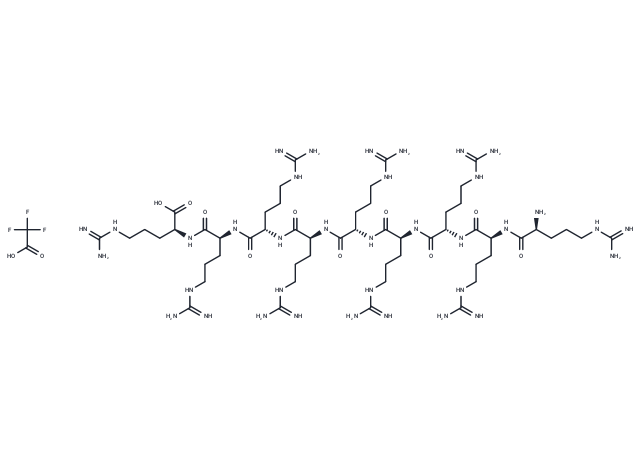Shopping Cart
- Remove All
 Your shopping cart is currently empty
Your shopping cart is currently empty

(Arg)9 TFA (Peptide R9 TFA) is a cell-penetrating peptide. (Arg)9 TFA (Nona-L-arginine TFA) exhibits neuroprotective activity with an IC50 of 0.78 μM in the glutamic acid model.

| Pack Size | Price | Availability | Quantity |
|---|---|---|---|
| 1 mg | $139 | In Stock | |
| 2 mg | $216 | In Stock | |
| 5 mg | $422 | In Stock | |
| 10 mg | $613 | In Stock | |
| 25 mg | $957 | In Stock | |
| 50 mg | $1,290 | In Stock | |
| 100 mg | $1,730 | In Stock |
| Description | (Arg)9 TFA (Peptide R9 TFA) is a cell-penetrating peptide. (Arg)9 TFA (Nona-L-arginine TFA) exhibits neuroprotective activity with an IC50 of 0.78 μM in the glutamic acid model. |
| Targets&IC50 | Neuroprotection:0.78 μM (IC50) |
| In vivo | (Arg)9) (D-isoform) is neuroprotective in rat stroke models. (Arg)9) is highly neuroprotective, with efficacy increasing with increasing arginine content. It has the capacity to reduce glutamic acid-induced neuronal calcium influx and requires heparan sulfate preotoglycan-mediated endocytosis to induce a neuroprotective effect[2]. (Arg)9) (D-isoform) administered intravenously at a dose of 1000 nmol/kg 30 min after permanent middle cerebral artery occlusion (MCAO) reduces infarct volume[3]. |
| Alias | Peptide R9 (TFA), Nona-L-arginine (TFA), (Arg)9 TFA |
| Molecular Weight | 1537.71 |
| Formula | C56H111F3N36O12 |
| Cas No. | 2283335-13-5 |
| Smiles | C(C(O)=O)(F)(F)F.[C@H](C(N[C@H](C(N[C@H](C(N[C@H](C(N[C@@H](CCCNC(=N)N)C(O)=O)=O)CCCNC(=N)N)=O)CCCNC(=N)N)=O)CCCNC(=N)N)=O)(NC([C@@H](NC([C@@H](NC([C@@H](NC([C@H](CCCNC(=N)N)N)=O)CCCNC(=N)N)=O)CCCNC(=N)N)=O)CCCNC(=N)N)=O)CCCNC(=N)N |
| Relative Density. | no data available |
| Storage | keep away from moisture | Powder: -20°C for 3 years | In solvent: -80°C for 1 year | Shipping with blue ice. | ||||||||||||||||||||
| Solubility Information | H2O: 10 mM, Sonication is recommended. DMSO: Insoluble | ||||||||||||||||||||
Solution Preparation Table | |||||||||||||||||||||
H2O
| |||||||||||||||||||||

Copyright © 2015-2025 TargetMol Chemicals Inc. All Rights Reserved.